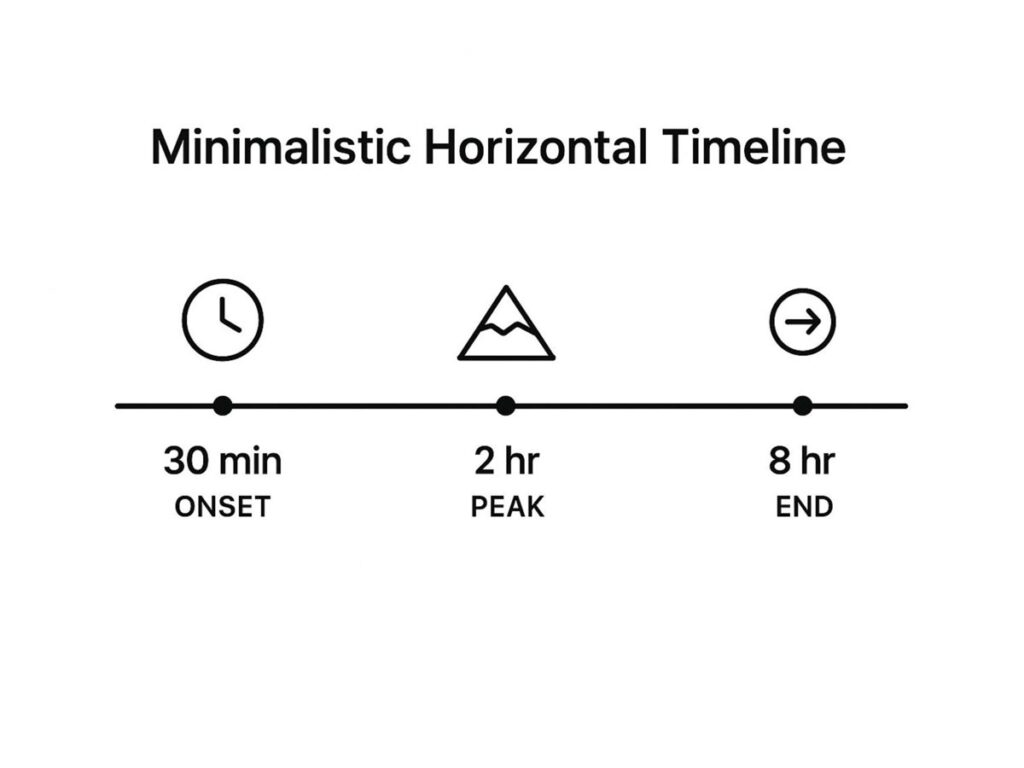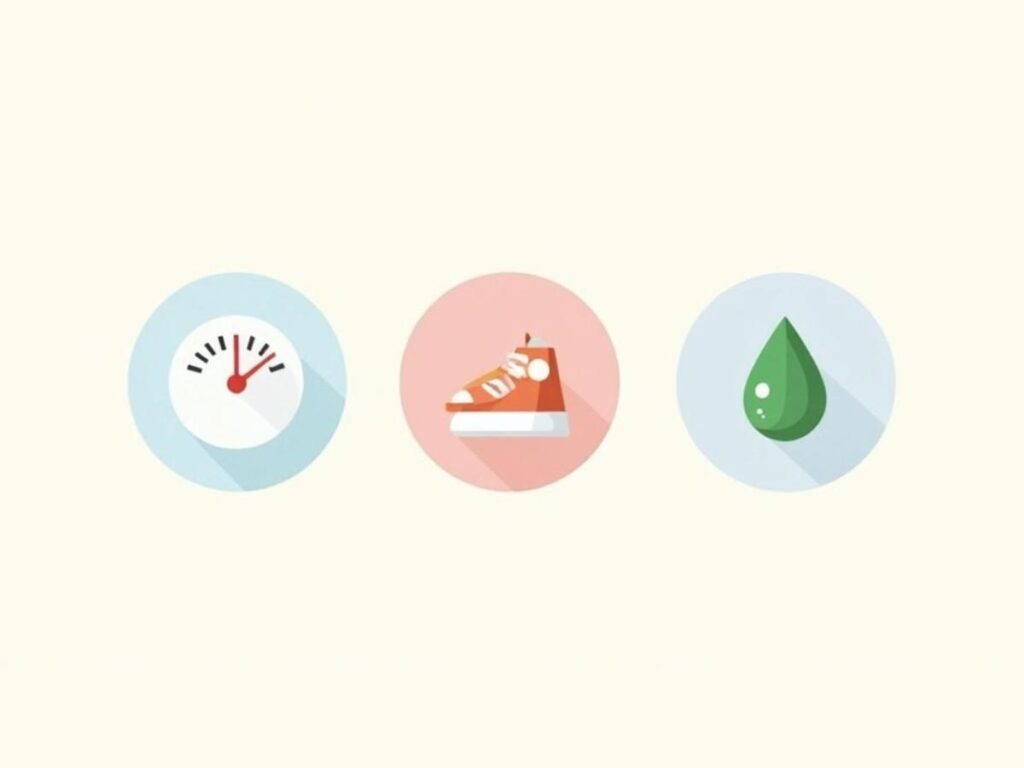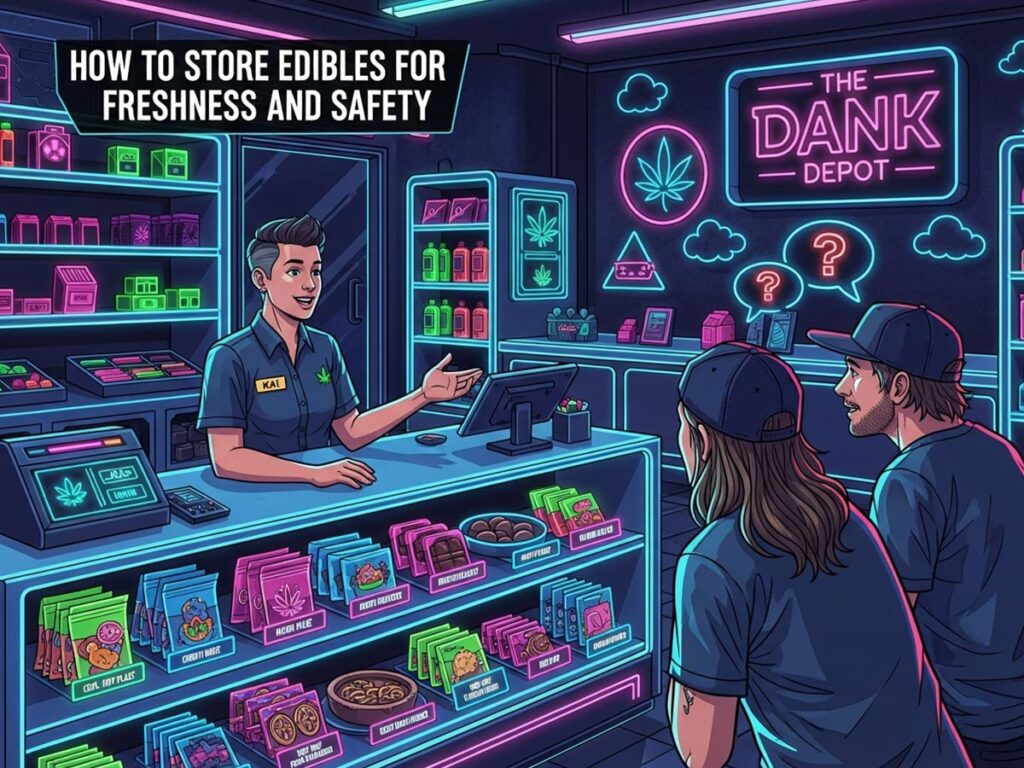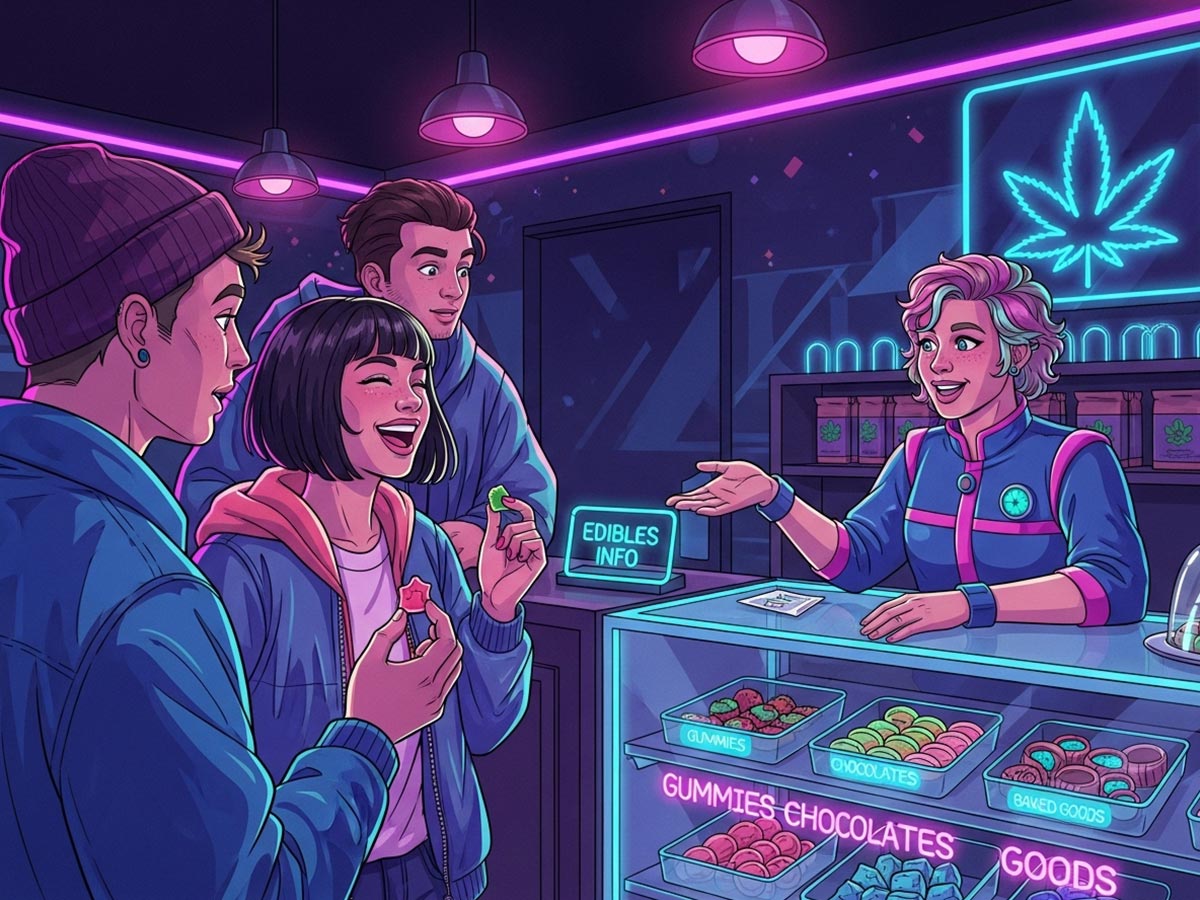So, you’re ready to explore cannabis edibles, but one big question is on your mind: how long do the effects actually last? It’s a smart question. Unlike smoking or vaping, which deliver a fast-acting but short-lived experience, edibles offer a journey—a slow-building, long-lasting ride that can be deeply satisfying when you know what to expect.
So, what’s the timeframe? The entire experience, from the first subtle sign to the final gentle fade, can last anywhere from 4 to 12 hours. Think of it as a scenic road trip, not a drag race. This extended duration is what makes edibles so unique, but it’s also why understanding the timeline is your key to unlocking a fantastic experience.
Your Edibles Experience: The Complete Timeline
Mastering the edible timeline is the secret to a perfect experience. It isn’t an instant on switch; it’s more like a slow-burning candle. It takes time to light, builds to a bright, beautiful peak, and then gracefully fades. This gradual arc is precisely why patience isn’t just a virtue—it’s a necessity.
This timeline gives you a clear roadmap for the journey ahead, from onset to peak and the gentle comedown.

As you can see, the whole adventure unfolds over several hours. Keeping this visual in mind is the best way to stop yourself from making the classic mistake of taking a second dose too early.
Let’s break down each phase of your journey.
Phase 1: The Onset (30 to 90 Minutes)
This is the waiting room. After you consume an edible, it needs to travel through your digestive system and be processed by your liver before the active compounds can enter your bloodstream. This metabolic voyage is exactly why you don’t feel the effects immediately.
The exact timing depends on factors like your personal metabolism and whether you ate on an empty stomach, but this initial window is a true test of patience. The #1 rookie mistake? Assuming it’s not working and reaching for more.
The Golden Rule of Edibles: “Start low and go slow.” Give your body at least two full hours to reveal the full effects. This simple act of patience is the difference between a great time and an overwhelming one.
Phase 2: The Peak (2 to 4 Hours After Onset)
Once the effects begin, they don’t just arrive—they build. The feeling will gradually intensify until it reaches its strongest point. This is the peak, and it’s where you’ll experience the full power of the edible. For most people, this happens about 2 to 4 hours after the effects first started.
During the peak, you’ll likely notice the high is more intense and body-focused compared to smoking. Why? Because when your liver processes THC, it transforms it into a more potent compound called 11-hydroxy-THC. This powerful metabolite is the secret ingredient behind the unique, long-lasting edible experience.
Phase 3: The Descent (4 to 12+ Hours)
After hitting that beautiful peak, the effects will start to gently taper off. This comedown is typically a slow and gradual cruise, leaving you with a mellow, relaxed feeling that can linger for several more hours.
How long this final phase lasts depends entirely on the dose and your personal tolerance. A newcomer who took a low dose might feel completely back to baseline within 4 to 6 hours. In contrast, an experienced consumer on a higher dose could easily feel some residual effects for 12 hours or even longer.
This table offers a practical look at what you might expect based on your experience level.
Typical Edible Effects Timeline
| Stage | Beginner User (Low Tolerance) | Occasional User (Medium Tolerance) | Frequent User (High Tolerance) |
|---|---|---|---|
| Onset | 45 – 90 minutes | 45 – 75 minutes | 30 – 60 minutes |
| Peak | 2 – 3 hours | 2 – 4 hours | 2 – 4 hours |
| Total Duration | 4 – 6 hours | 6 – 8 hours | 8 – 12+ hours |
Ultimately, treat this as a guide, not a guarantee. Your body is unique—listen to its signals above all else.
Why Edibles Have a Delayed Effect
If you’ve ever waited for an edible to kick in, glancing at the clock and wondering, “Is this thing working?”—you’re not alone. That signature delay is a core part of the experience, and it’s all thanks to the unique metabolic path cannabis takes when you eat it. Unlike other ways to consume cannabis that offer immediate results, edibles play the long game.
Here’s a simple analogy: smoking is like sending a text—it arrives instantly via your lungs. Eating an edible is like mailing a letter; it has to go through the entire postal service of your digestive system before it’s delivered.
The Journey Through Your Digestive System
When you eat an edible, it first travels to your stomach to be broken down. From there, it moves through your intestines and finally arrives at the main processing hub: your liver. This entire digestive tour is responsible for the 30- to 90-minute delay before you feel anything.
Understanding this biological process is the first step to becoming a confident edible consumer. It empowers you to plan your experience and avoid the impatience that leads to overconsumption.
What is First-Pass Metabolism
Your liver is the magic-maker in the edible equation. It subjects the active ingredients to a process called first-pass metabolism, where the real transformation happens. Before THC can enter your bloodstream, your liver converts it into something entirely new—and significantly more potent.
Think of your liver as a chemical conversion plant. The original delta-9-THC from the edible goes in, gets processed, and comes out as a supercharged compound ready to be sent to the rest of your body.
The Key Transformation: During first-pass metabolism, your liver converts standard delta-9-THC into 11-hydroxy-THC. This new compound is far more potent and crosses the blood-brain barrier with ease, which is why edibles can feel stronger, last longer, and produce more of a full-body high than inhaled cannabis.
This metabolic alchemy is the science behind the distinct edible “high.” It explains not just the long wait, but also the profound intensity and duration of the effects. It’s why patience isn’t just a suggestion—it’s your most important tool for a safe and enjoyable time.
Factors That Influence Your Edible Experience

Ever wondered why you and a friend can take the same 10mg gummy and have wildly different experiences? The effects of an edible are deeply personal, shaped by a handful of unique biological factors. It’s not a one-size-fits-all product; it’s a personal journey.
Understanding these variables puts you in control. When you know how your body is likely to react, you can move from guessing to making informed decisions, ensuring a predictable and enjoyable outcome every time.
Let’s explore the key factors that will shape your ride.
Your Metabolism and Body Composition
Your metabolism is your body’s engine speed. A fast metabolism processes everything quickly, from food to THC. For example, if you’re someone who gets hungry again shortly after a big meal, your body might process an edible faster, leading to a quicker onset but a shorter overall duration.
Conversely, a slower metabolism takes its time, which can mean a longer wait for the effects to begin but a high that lingers. Body composition, including weight and body fat percentage, also plays a crucial role, as cannabinoids can be stored in fat cells and released over time.
Your Tolerance Level
Your history with cannabis is perhaps the single biggest predictor of your experience. Regular use builds tolerance, meaning your body adapts and requires a higher dose to achieve the same effects. The high may also feel less intense and not last as long compared to a novice.
For a true beginner, a small 5 mg dose can feel powerful and last for hours. A standard 10 mg gummy might produce effects for 6-8 hours for an occasional consumer, but that same dose could last just 4 hours for a daily user or up to 12 hours for a first-timer.
Actionable Insight: Be honest about your tolerance. If you’re new or returning after a long break, treat yourself as a beginner. Start with a microdose (1-2.5 mg) to see how you feel. It’s much better to be pleasantly surprised than uncomfortably overwhelmed.
What You Have Eaten Recently
What—and when—you’ve eaten can dramatically alter your edible experience. Taking an edible on an empty stomach often leads to a faster, more intense onset because there’s nothing else for your digestive system to work on. However, the effects might also fade more quickly.
For a smoother, longer-lasting experience, try taking your edible with or after a meal containing healthy fats. THC is lipophilic, meaning it binds to fat. Practical example: eating your gummy after a snack like an avocado, a handful of nuts, or a piece of cheese can enhance absorption and lead to a more gradual and sustained effect.
By mastering these variables—metabolism, tolerance, and food intake—you can transform your edible experience from a roll of the dice into a predictable and personalized journey.
Finding Your Ideal Dose Safely
Embarking on your edible adventure is exciting, but let’s be clear: dosing is everything. Getting it right is the difference between a blissful experience and an uncomfortable one. Thankfully, the guiding principle is beautifully simple: start low and go slow. This isn’t just a catchy phrase; it’s the single most important piece of advice for finding your perfect dose safely.
Remember, the effects of edibles are potent and long-lasting, making a cautious approach non-negotiable. A small amount can go a long way, especially for beginners.
Understanding Edible Dosages
One of the greatest benefits of buying from a licensed dispensary is precision. The packaging removes all guesswork, clearly stating the total milligrams (mg) of THC in the product and the dosage per serving.
Here’s a practical guide to what those numbers mean for your experience:
- Microdose (1 – 2.5 mg THC): The ideal starting point for beginners or those highly sensitive to THC. Expect subtle relief from symptoms like pain or anxiety with little to no intoxication.
- Standard Beginner Dose (2.5 – 5 mg THC): The sweet spot for most new users. This dose typically produces noticeable effects, including euphoria, heightened senses, and significant symptom relief.
- Experienced User Dose (10 – 25 mg THC): This range is for seasoned consumers with a developed tolerance. It can produce strong psychoactive effects and should be avoided by novices.
Remember: These are just guidelines. Your unique body chemistry is the final authority. The goal is to discover your personal sweet spot, not to match someone else’s dose.
Your First-Time Dosing Strategy
Ready to start? A methodical, patient strategy will ensure your first time is a positive one. Here’s your step-by-step plan for success:
- Read the Label Carefully: Before you do anything, examine the package. If a single gummy is 10 mg, start by cutting it in half (5 mg) or even into a quarter (2.5 mg).
- Start with a Small Dose: Always begin with the lowest practical dose. You can always take more later, but you can never take less.
- Wait at Least Two Full Hours: This is the most crucial step. Set a timer. Your body needs this time to digest and metabolize the edible. Do not even consider taking more until two hours have passed.
- Assess and Re-dose Cautiously: After two hours, check in with yourself. How do you feel? If the effects are too mild or absent, you can consider taking another small amount, like 1-2.5 mg.
This patient approach is the smartest way to learn your body’s response and build a positive relationship with edibles.
And if you’re ready to try your hand at homemade treats, proper dosing is even more critical. Get the fundamentals right by exploring our guide to baking with cannabis, which will teach you how to create safe and consistent goodies from scratch.
How to Store Edibles for Freshness and Safety

Treat an edible like any other food item—because that’s what it is. Proper storage is essential. It doesn’t just prevent your treats from going stale; it preserves their potency and, most importantly, keeps them safe to consume.
To keep your edibles fresh, potent, and safe, you must protect them from their four natural enemies: heat, light, air, and moisture. This destructive quartet works together to degrade both the food ingredients and the cannabinoids. Heat and light rapidly break down THC, while air and moisture invite mold and bacteria to the party.
Fortunately, protecting your investment is simple.
Best Practices for Storing Edibles
The golden rule is to find a cool, dark, and dry place. A pantry, cupboard, or bedroom drawer is often perfect. The key is to avoid locations with frequent temperature fluctuations, like the cabinet above your stove.
Follow these actionable tips for maximum freshness:
- Use Airtight Containers: While original packaging is a good start, transferring edibles to a glass or metal airtight container is even better. This locks out oxygen and moisture, preserving both texture and potency.
- Keep it Dark: Light is a primary culprit in THC degradation. If you use a clear container, make sure to store it in a dark place like a drawer or cabinet.
- Refrigerate Smartly: For baked goods like brownies or cookies, the refrigerator can extend freshness by a few days. To prevent them from drying out, always use a well-sealed container.
- Freeze for Long-Term Storage: The freezer is your best friend for long-term preservation. This is especially effective for items like infused butters and oils, keeping them fresh for months. You can learn to make your own with our guide to making cannabis olive oil.
Practical example: A package of gummies stored in an airtight container in a cool, dark pantry can easily remain fresh and potent for 6 months to a year. The same gummies left in a warm, sunny spot could lose significant potency and become a breeding ground for mold in a fraction of that time.
Telltale Signs Your Edibles Have Gone Bad
When in doubt, trust your senses. If an edible looks, smells, or feels off, it probably is. Regulatory bodies like Nevada’s cannabis product guidelines emphasize shelf-life stability for a reason—it’s about consumer safety.
Immediately discard any edible if you notice these red flags:
- A Funky Smell: Any rancid, sour, or “off” odor is a clear warning.
- Visible Mold: If you see fuzzy spots, discoloration, or any powdery substance, throw it out. No exceptions.
- Bad Texture: Has your gummy become slimy or hard as a rock? Is your cookie tough and unappealing? It’s past its prime.
Edible Shelf Life vs. Potency: What You Need to Know
When people ask, “how long do edibles last?”, they’re often asking two different questions. We’ve covered the duration of the effects, but what about the shelf life of the product itself? The answer hinges on freshness and potency.
The most significant factor is the ingredients. A decadent, freshly baked brownie with eggs and butter will naturally have a much shorter shelf life than a simple gummy made of sugar and gelatin. Like any food, edibles can become stale, grow mold, and spoil.
The Slow Fade: How THC Ages into CBN
Over time, an edible doesn’t just lose its taste and texture; its chemical profile changes. When exposed to oxygen, heat, and light, THC gradually degrades and converts into a different cannabinoid: CBN (cannabinol).
CBN is only mildly psychoactive and is best known for its sedative properties.
The Takeaway: An old edible isn’t just a stale snack—it’s a chemically different product. A gummy that’s a year past its prime won’t just taste bad; it will also be significantly less potent. Instead of the uplifting high you were expecting, you might just feel sleepy. This natural degradation process is why paying attention to expiration dates is crucial for getting the experience you desire.
In regulated markets, cannabis companies are required to conduct stability testing to determine a reliable “best by” date. This ensures you’re getting a product that is both safe and effective.
Why You Shouldn’t Ignore That Expiration Date
That date on the package is your best guide to a quality experience. Here’s a general idea of what to expect:
- Baked Goods: Cookies, brownies, and other perishable treats have a short shelf life, typically just a few days to a week. Refrigeration or freezing is a must for extending their life.
- Gummies and Hard Candies: These products are built for longevity. With low moisture content, they can remain fresh and potent for six months to over a year when stored correctly.
Following these dates is the surest way to guarantee you’re getting the safe, consistent, and potent experience you paid for.
Got Questions About Edibles? We’ve Got Answers.
Stepping into the world of edibles naturally brings up questions. We’re here with clear, actionable answers to help you feel confident and prepared.
What Happens If I Eat an Expired Edible?
There are two risks. The first is food safety: an old edible can grow mold or bacteria that could make you sick. It’s simply not worth it.
The second is a disappointing experience. As THC degrades into the sedative cannabinoid CBN, you won’t get the effect you’re looking for. Instead of a pleasant high, you’re more likely to feel tired. For safety and quality, it’s always best to discard expired products.
Can I Make Edible Effects Wear Off Faster?
Unfortunately, there is no magic “off” switch. Once the THC is in your system, your body has to metabolize it, and that takes time.
However, you can manage the experience if you feel overwhelmed. The best course of action is to stay calm, hydrate with water, have a light snack, and find a comfortable, safe space to relax. Most importantly, remind yourself that the feeling is temporary and it will pass.
Actionable Tip: Many people find that CBD can help counteract the anxiety and paranoia sometimes associated with taking too much THC. While it won’t make you sober, taking CBD can often smooth out the rough edges of a too-intense high.
How Long Do Edibles Stay in Your System?
The effects of an edible last for hours, but the metabolites can remain in your system for much longer. Drug tests don’t look for active THC; they screen for these inactive byproducts.
How long they are detectable depends heavily on your usage patterns:
- Occasional users: Metabolites may be detectable in urine for up to a week.
- Frequent or heavy users: THC can be detectable for 30 days or more.
Factors like your metabolism, body fat percentage, and consumption frequency all influence this window. For more in-depth scientific information, you can turn to trusted sources like the National Institutes of Health.
Ready to find fresh, high-quality edibles with clear dosing and expiration dates? At Wallflower Cannabis House, our knowledgeable budtenders are here to help you choose the perfect product for a safe and enjoyable experience.

